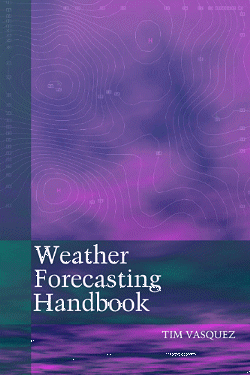FIFTH EDITION
by Tim Vasquez
2001 / 204 pp. / 192 illustrations / $29.95 / ISBN 0-9706840-2-9
7 x 10" / True bound / Offset print / Glossy color cover
|
The Information Age has blossomed and now anyone can run a weather center from their own office or home. Unfortunately, nearly all popular weather books are nothing more than essays on the science of meteorology. The Weather Forecasting Handbook breaks the mold by explaining all the latest forecasting principles, techniques, and tools. This readable book is a valuable reference for professionals, students, amateurs, storm chasers, sailors, and anyone who needs to know the exact fundamentals and mechanics of weather forecasting.
Basic physical concepts are reviewed, and commonly-employed analysis methods are presented. Then weather systems are explained in terms of their thermal structure, dynamics, and effects. Special problems such as thunderstorms, winter weather, and tropical weather get chapters of their own. Margins are filled with forecasting facts, hard-hitting quotes, educational stories, and even a few fun weather jokes. With added emphasis on analysis, visualization, and awareness of model limitations, readers learn to use tools properly and are always a step ahead. Due to the book's recent demand by universities, the latest edition adds ten review quesions at the end of each chapter (answers not printed but are available on this web site).
With the Weather Forecasting Handbook, some common sense, and a little math knowledge, almost anyone can learn to forecast the weather, and even have fun doing it!
Incredible coverage
The Weather Forecast Handbook is broken down into a dozen chapters:- FUNDAMENTALS -- A basic overview of density, pressure, mixing ratio, is followed by a description of scale, atmospheric structure, the global circulation, and the pressure coordinate system.
- OBSERVATION -- Where do those observations come from? You'll see how temperature, dewpoint, wind, clouds, and other phenomena are measured. The chapter sticks to what is important to forecasters.
- TOOLS -- Learn to use the surface chart, and upper-air charts. A section on radar and doppler radar follows (showing how to interpret severe signatures), then satellite imagery, soundings, and hodographs are discussed in detail.
- PHYSICS -- This chapter touches on phase changes, adiabatic changes, stability, atmospheric forces, and winds.
- FRONTS AND JETS -- You'll learn frontal concepts, the types of fronts, drylines, air masses, tertiary circulations, and jets.
- MOTION -- This large chapter gets into the heart of dynamics, explaining long waves, short waves, convergence, vertical motion, and jet stream dynamics. You'll also learn about vorticity, Q-vectors, and isentropic analysis.
- BAROTROPIC SYSTEMS -- Covers the various types of cold-core and warm-core lows and highs found in everyday analysis, from cutoff lows and the polar vortex to hurricanes and heat lows.
- BAROCLINIC SYSTEMS -- Explains baroclinic lows and highs, how they develop and dissipate, and common variations usually seen in everyday analysis.
- CONVECTIVE WEATHER -- Covers structure and types, including odd variations such as derechos, splits, MCSs, and the supercell spectrum. Lists the various convective parameters used today, such as CAPE, EHI, and BRN.
- WINTER WEATHER -- A brief chapter that covers different precipitation types caused by various vertical thermal structures.
- TROPICAL WEATHER -- Learn about the equatorial trough, the subtropical ridge, easterly waves, TUTTs, tropical cyclones, and more.
- NUMERICAL GUIDANCE -- Describes the prediction process, classes, domains, configurations, and operational models currently used. Also explains the limitations of models.
- APPENDIX -- Code quick reference, reading, software, educational web sites, government weather agency web sites, forecasting myths, and twelve practice exercises.
Who it's for
With unrestricted technical content that's light on theory and complex information, the Weather Forecasting Handbook makes a great selection for avid professionals, weather enthusiasts, storm chasers, emergency managers, broadcasters, boaters, and anyone who wants to learn practical, everyday forecasting in an refreshing format.Used by universities!
Weather Forecasting Handbook is part of the curricula at College of Dupage, St. Louis University, University of Texas (Austin), University of North Dakota, St. Cloud State University, Jacksonville State University, University of Georgia, and Valparaiso University.Extra goodies!








